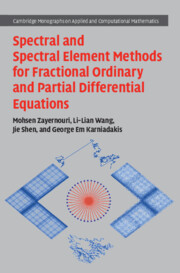2756 results

Spectral and Spectral Element Methods for Fractional Ordinary and Partial Differential Equations
- Coming soon
-
- Expected online publication date:
- November 2024
- Print publication:
- 30 November 2024
-
- Book
- Export citation
EXPERIMENTAL CONDITIONS FOR 14C GRAPHITE PREPARATION AT THE GXNU LAB, CHINA
-
- Journal:
- Radiocarbon , First View
- Published online by Cambridge University Press:
- 20 September 2024, pp. 1-13
-
- Article
- Export citation
α-Klotho: the hidden link between dietary inflammatory index and accelerated ageing
-
- Journal:
- British Journal of Nutrition , First View
- Published online by Cambridge University Press:
- 20 September 2024, pp. 1-7
-
- Article
- Export citation
SAMPLE PREPARATION SYSTEM FOR CARBONATE AND DIC IN WATER AT THE GXNU-AMS LABORATORY
-
- Journal:
- Radiocarbon , First View
- Published online by Cambridge University Press:
- 18 September 2024, pp. 1-12
-
- Article
- Export citation
Relative dispersion in free-surface turbulence
-
- Journal:
- Journal of Fluid Mechanics / Volume 993 / 25 August 2024
- Published online by Cambridge University Press:
- 13 September 2024, R2
-
- Article
- Export citation
Effects of supplementing tributyrin on serum biochemical indices and meat quality characteristics of longissimus thoracis et lumborum of weaned Small-Tailed Han lambs
-
- Journal:
- Animal Nutriomics / Accepted manuscript
- Published online by Cambridge University Press:
- 11 September 2024, pp. 1-49
-
- Article
-
- You have access
- Open access
- Export citation
Onset of turbulence in rotor–stator cavity flows
-
- Journal:
- Journal of Fluid Mechanics / Volume 991 / 25 July 2024
- Published online by Cambridge University Press:
- 28 August 2024, A3
-
- Article
- Export citation
Brain magnetic resonance imaging outperforms clinical severity ratings in the prediction of treatment outcomes in major depressive disorder
-
- Journal:
- European Psychiatry / Volume 67 / Issue S1 / April 2024
- Published online by Cambridge University Press:
- 27 August 2024, p. S85
-
- Article
-
- You have access
- Open access
- Export citation
A multivariate meta-analysis of peripheral cytokine levels in obsessive compulsive disorder
-
- Journal:
- European Psychiatry / Volume 67 / Issue S1 / April 2024
- Published online by Cambridge University Press:
- 27 August 2024, pp. S42-S43
-
- Article
-
- You have access
- Open access
- Export citation
Childhood socio-economic disadvantages versus adverse care experiences: Mediation and moderation impacts on late-life depressive symptoms
-
- Journal:
- European Psychiatry / Volume 67 / Issue 1 / 2024
- Published online by Cambridge University Press:
- 27 August 2024, e47
-
- Article
-
- You have access
- Open access
- HTML
- Export citation
Functional connectivity subtypes of MDD and their associations with gene expression profile, neurotransmitter, and cognition
-
- Journal:
- European Psychiatry / Volume 67 / Issue S1 / April 2024
- Published online by Cambridge University Press:
- 27 August 2024, p. S362
-
- Article
-
- You have access
- Open access
- Export citation
Jet mixing enhancement with Bayesian optimization, deep learning and persistent data topology
-
- Journal:
- Journal of Fluid Mechanics / Volume 991 / 25 July 2024
- Published online by Cambridge University Press:
- 20 August 2024, A5
-
- Article
- Export citation
Spatial and temporal patterns of disease burden attributable to high BMI in Belt and Road Initiative countries, 1990–2019
-
- Journal:
- Public Health Nutrition / Volume 27 / Issue 1 / 2024
- Published online by Cambridge University Press:
- 05 June 2024, e158
-
- Article
-
- You have access
- Open access
- HTML
- Export citation
Investigations on the turbulent
 ${\boldsymbol{/}}$non-turbulent interface in supersonic compressible plate turbulent boundary layer
${\boldsymbol{/}}$non-turbulent interface in supersonic compressible plate turbulent boundary layer
-
- Journal:
- Journal of Fluid Mechanics / Volume 988 / 10 June 2024
- Published online by Cambridge University Press:
- 03 June 2024, A30
-
- Article
- Export citation
The amino acid sensor methionyl-tRNA synthetase is required for methionine-induced milk protein synthesis in a domestic pigeon model
-
- Journal:
- British Journal of Nutrition , First View
- Published online by Cambridge University Press:
- 03 June 2024, pp. 1-16
-
- Article
- Export citation
Early Holocene exploitation of taro and yam among southern East Asian hunter-gatherers
-
- Article
-
- You have access
- Open access
- HTML
- Export citation
On a class of self-similar sets which contain finitely many common points
- Part of
-
- Journal:
- Proceedings of the Royal Society of Edinburgh. Section A: Mathematics , First View
- Published online by Cambridge University Press:
- 30 May 2024, pp. 1-22
-
- Article
- Export citation
Effect of age of first exposure on L2 contextual lexical semantic learning: an ERP investigation
-
- Journal:
- Language and Cognition , First View
- Published online by Cambridge University Press:
- 28 May 2024, pp. 1-35
-
- Article
-
- You have access
- Open access
- HTML
- Export citation
Long-term outcomes of repair in children with total anomalous pulmonary venous connection
-
- Journal:
- Cardiology in the Young , First View
- Published online by Cambridge University Press:
- 27 May 2024, pp. 1-10
-
- Article
- Export citation
Model and algorithm for pharmaceutical distribution routing problem considering customer priority and carbon emissions
-
- Journal:
- Data-Centric Engineering / Volume 5 / 2024
- Published online by Cambridge University Press:
- 27 May 2024, e16
-
- Article
-
- You have access
- Open access
- HTML
- Export citation





















